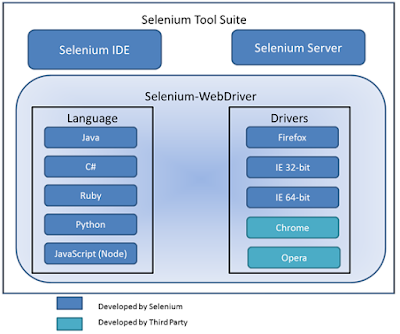Automation
of testing has become an integral part of the software development cycle for
small and medium enterprises. This gains more value as and when the development
of corresponding online services and e-commerce operations begin. If test
automation isn’t undertaken especially during this stage the organization would
have to deal with unprecedented cost overheads as a result of low performance
and service delay. Learn
QA/QTP testing training to become a successful automation professional.
Selenium
is a group of various software tools each with a varying test automation
process, technique or approach. While conventionally Test Automation Engineers
tend to focus on the one or two relevant tools that will most likely meet the
said project needs, it is wise to learn the entire set of testing tools to have
options at the ready for solving various test automation cases. The Selenium
suite of tools leads is feature packed and is specifically equipped to the
requirements of testing for web applications of all types. The processes
enabled by Selenium are known to be highly flexible, enabling many choices for
location of UI elements and contrasting forecasted test results as against actual
application functioning. One of the best features of Selenium is its ability to
allow testing on various browser platforms.
Test automation key benefits
IT enterprises looking to boost overall software efficiency and build on existing software quality are looking towards test automation as a solution. Whether the
objective is to execute automated test cases or contrasting expected and actual
results, there are specialized tools available for effective testing. This way,
software proficiency can be achieved and enhanced greatly without manual
intervention which conventionally happens at repeated intervals.
Faster feedback
Automation
enhances communication between product owners, developers and designers which
enable malfunctions, bugs and other errors to be instantly identified and
corrected in real-time. This is why automated testing is highly advantageous
and acts as a catalyst for validation of the product during the different
phases of the software development cycle.
Accelerated results
Accelerated
implementation of test automation will lead to massive savings in operational
time for both small and large systems. This means testing can be executed on a
repetitive basis, which in turn will deliver speedier results every time with
minimized time and reduced effort.
Higher overall test coverage
The
sheer speed of test automation allows for a greater number of test executions
relating to an application. This directly translates to higher test coverage
than possible in manual testing, which usually would involve a massive team
restricted by a small amount of allotted time. Maximizing test coverage means
more features in the application can be tested leading to higher quality for
the application.
Reusability of automated tests
The
fact that automated test cases are reusable means they can be used through
various approaches. This means developers get the chance to assess program
reactions. The repetitive nature of test automation facilitates this.
Earlier detection of defects
Since
early defect detection leads to cost-effective code rework, overall velocity of
code development can be maintained at high average while still making sure
functionality isn’t hampered across areas. This is the reason why defect
documentation in software becomes much easier for testing teams post-test
automation implementation.
Thoroughness in testing
It
is a statistical certainty that all testers may not use similar testing
approaches. Testers focus areas within the application may vary to a great degree
based on the personal expertise and exposure to certain practices in testing.
When test automation comes into the picture, all areas of testing are bound to
receive the same amount of attention. This will directly translate to higher
product quality.
Benefits of Automating Functional Tests Using
Selenium for Enterprises
Platform portability
Since
we have established that testing is a repetitive process, the smallest
variations in code must be thoroughly tested to make sure the intended
functionality is met. Selenium is a testing tool with high levels of
portability which can run on various platforms and browsers as well. Learn more
about selenium from
Selenium training
by Learn IT Training.
Language support
One
of the key challenges in software test automation is the integration of
automation tools with the development environment for CI. Easy integration with
the development environment is made a reality with the available Selenium
bindings for Python, PHP, Ruby, Java (see
Java online training for advanced concepts), .NET, Perl, and a lot more.
Flexibility
Test
management becomes much simpler and more efficient, thanks to easy regrouping
and refactoring of test cases. This enables the testers to keep testing
self-contained and we’ll within the program itself. This leads to better change
management in the code, minimizing complications and boosting maintainability
of the said code. This is why Selenium is known for its flexibility as a
testing tool.
Open source advantage
Being
open source, selenium enables user sharing and users to extend and change
existing code. This, in turn, allows testers in reaping huge ROIs by saving
time and effort. Custom functions also enable higher readability and better
management of code.
Conclusion
It
is because Selenium is such a diverse testing package, enterprises the world
over have begun using this tool for testing software applications varying from
the simple to the highly complex. Right from its open source nature to its
cross-platform compatibility, everything in this testing suite offer
organizations the best of the best when it comes to testing automation.
Learn
more from QA testing training by learn IT Training, which is one of the best
global online training Portal for the students. We provide
SAP Training and many other IT courses training based on specific
needs of the learners especially we will give innovative one to one classes
which has great opportunities in the present IT market. Learners can grasp the
technical-subject technical and practical knowledge from highly experienced and
certified trainers.
For more details contact us:
INDIA: +91 9912989639
USA: +12108585008
Contact@learnittraining.com
Skype:Learn IT Training
WhatsApp: +91 9912989639
































